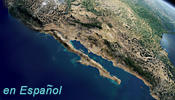![[Ocean Oasis Field Guide]](images/bnr-oo-field.gif)

![[Ocean Oasis Field Guide]](images/bnr-oo-field.gif) |  |
|
Coastal wetlands are an important part of the marine habitat, providing a rich source of nutrients for ocean-dwelling organisms and also a nursery for young fish and marine invertebrates. On the Gulf coast, and southern Pacific coast of Baja California Sur, many of these wetlands are bordered by shrubs and trees called mangroves. Mangrove wetlands are found closest to the sea and are flooded by daily tides. Red Mangrove (Rhizophora mangle) displays characteristic prop roots. Black (Avicennia germinans) and White (Laguncularia racemosa) Mangroves can usually be found landward of the Red Mangrove. Mangrove wetlands provide habitat and also prime nesting and migratory sites for hundreds of bird species. Mangroves support extensive coastal food webs, provide shoreline stability and erosion prevention, and storm protection. Mangrove forests literally live in two worlds at once, acting as the interface between land and sea. The mangroves act as buffers and catch sediment and alluvial materials, thus stabilizing land elevation by promoting sediment buildup in tidal areas. Vital coral reefs and sea grass beds are also protected from damaging siltation due to the filtering effects of Mangrove forests. The Origin of Mangroves Scientists theorize that the earliest mangrove species originated in the Indo-Malayan region. This theory is supported by the fact that there are more mangrove species present in this region than anywhere else in the world. Due to many species' unique floating propagules and seeds, early mangroves spread westward, by ocean currents, to India, East Africa, and eastward to the Americas, arriving in Central and South America during the upper Cretaceous period and lower Miocene epoch (66 and 23 million years ago). This may explain why the mangroves of the Americas contain fewer and similar colonizing species, while those of Asia, India, and East Africa contain a fuller range of mangrove species. Depending on the species, these propagules may float for extended periods, up to a year, and still remain viable. Viviparity and the long-lived propagules allow these mangrove species to disperse over wide areas. Certain mangrove species can propagate successfully in a marine environment because of special adaptations. Through viviparity, embryo germination begins on the tree itself; the tree later drops its developed embryos, called seedlings, which may take root in the soil beneath. Viviparity may have evolved as an adaptive mechanism to prepare the seedlings for long-distance dispersal, and for survival and growth within a harsh saline environment. During this viviparous development, the propagules are nourished on the parent tree, thereby accumulating the carbohydrates and other compounds required for later autonomous growth. The structural complexity achieved by the seedlings at this early stage of plant development helps acclimate the seedlings to extreme physical conditions which otherwise might prevent normal seed germination. Status of Mangrove Forests Naturally resilient, mangrove forests have withstood severe storms and changing tides for many millennia, but they are now being impacted by modern encroachments. Mangrove forests are currently among the most threatened habitats in the world and are disappearing at an accelerated rate. Lenticels in the exposed portions of mangrove roots are highly susceptible to clogging by crude oil and other pollutants, attacks by parasites, and prolonged flooding from artificial dikes and sea walls. Changes in the intertidal areas can reduce the productivity of the mangrove ecosystem and cause destruction through drastically changing the drainage areas and alluvial deposits, effectively starving the mangroves and the habitat. The intense chemical and biological activity in mangroves causes them to act as sinks which concentrate pollutants. Some of these pollutants are nutrient salts, organic wastes (sewage), toxic minerals (heavy metals), organic chemicals (pesticides and herbicides), suspended or floating substances that suffocate and reduce light and species diversity in the underwater section of the mangrove. Over time, environmental stress can kill large numbers of mangrove trees. In addition, the charcoal and timber industries have also severely impacted mangrove forests, as well as the developing tourism industry and other coastal developments. The rapidly expanding shrimp aquaculture industry poses a threat to the world's remaining mangroves. It has been estimated that thousands of hectares of mangrove forests have been cleared to make room for artificial shrimp ponds. The shrimp aquaculture industry has grown exponentially over the last decade, leaving impacted wetlands around the world. Protecting Mangrove Forests The primary goals of conservation and protection of coastal wetlands and mangrove forests are to increase public awareness and education about these habitats, provide designated conservation areas, and integrate coastal wetland/mangrove restoration into current coastal planning. National governments have not been able to regulate development and industry effectively to save many wetlands, and current developments are not adequately planned and implemented to provide conservation, restoration, and mitigation measures for nearby wetlands. Meanwhile, stricter local governmental regulations and enforcement protecting mangroves are necessary. Also, involvement of local communities in sustainably managing and protecting their coastal resource base, including the nearby mangrove forests, is essential. |
Text by Bob Lauri and Judy Gibson
Photographs by Jon Rebman © 2000 SDNHM
Field Guide |
Site Index |
Ocean Oasis Introduction
|
|
© 2000 San Diego Natural History Museum |